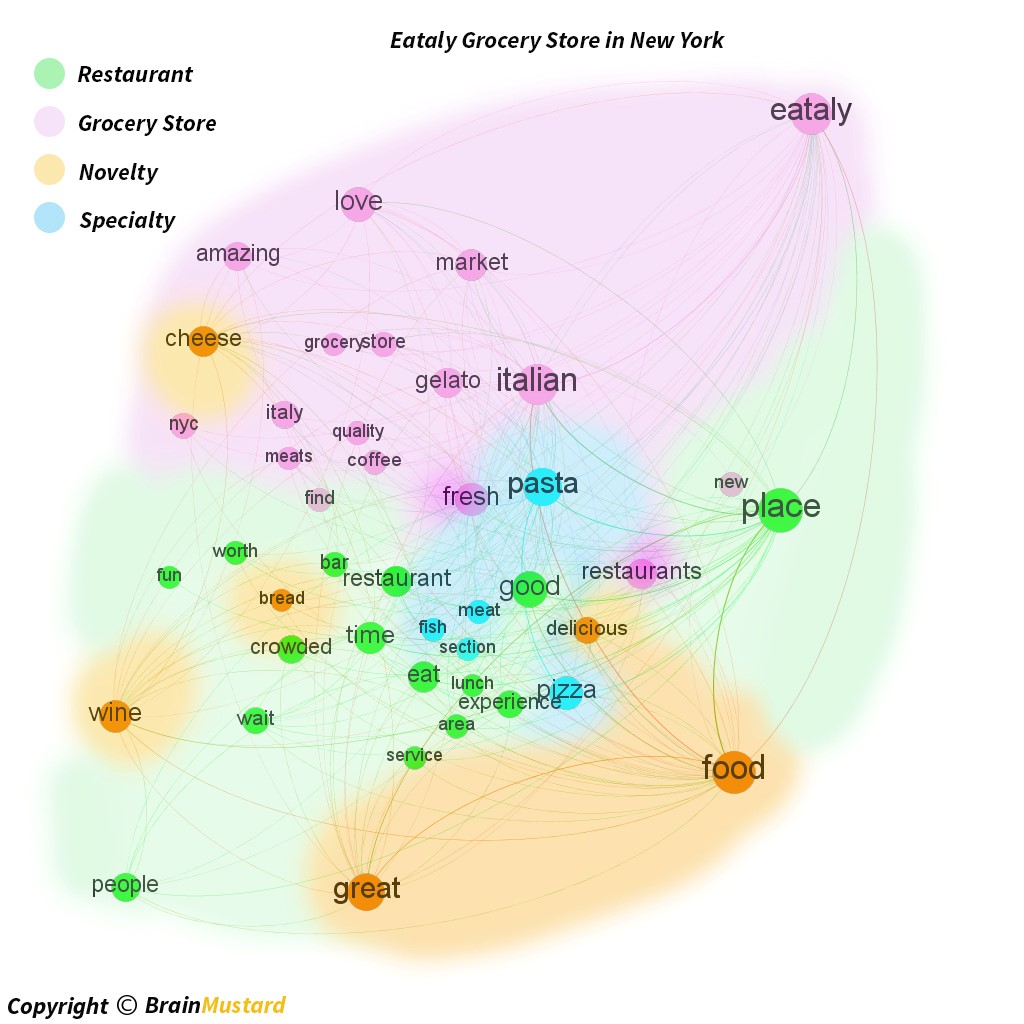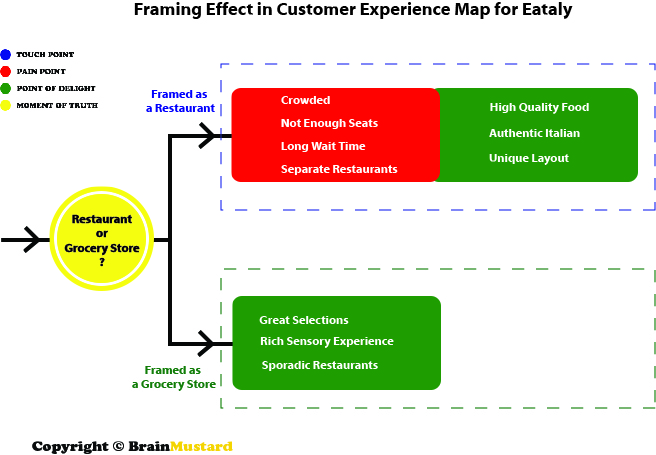Framing Effect in Retail Experience (Eataly)
BrainMustard Customer Experience Design Series
About this Article
The Customer Experience Series by BrainMustard are based on the customer experience maps and social influence graphs built from scanning and analyzing millions of contents from the Internet chatter.
These models and maps offer revealing and unexpected consumer insights to formulate new initiatives to increase sales. Check out our success stories at http://www.BrainMustard.com
Got a question?
- 10 Alcorn Ave. / #204 / Toronto / Canada
- 416-556-3909
- Contact@BrainMustard.com
Framing Effect in Retail Design
Local Florentines would be the first to tell you that Eataly is a high-end, authentic Italian grocery store which, in Florence, puts it in direct competition with other grocers like Carrefour and Asda. As a result of this, the news of Eataly making its way into the North America has become pretty unsettling for many high-end grocery stores such as Whole Foods Market and Pusaterie’s.
It all started in 2010, when Eataly was first brought to New York by a team of culinary geniuses, Mario Batali, and Joe and Lidia Bastianich. The first North American store was almost identical in layout and experience as to the ones in Florence and Turin, and was conveniently located in the city's busy intersection of 5th Avenue and 23rd. With roughly 100,000 people per square kilometer in this part of town, Eataly was sure to boom with business. And it did.
People from all over town swooped in on the already busy neighborhood to experience the real Italian lifestyle. Batali even described the ultimate sensory experience as a "grocery store with tasting rooms". However, his observation was an inaccurate one.
***
Wolfgang Kempelen was the creative genius of the eighteenth century who created a chess playing robot, the "mechanical turk". His invention captured the attention of millions, including Napoléon Bonaparte, who, to his ultimate dismay, lost a game of chess against the machine. Shows with the mechanical Turk were always sold out, as the magic of the chess machine worked its wonders on the people. The main reason for such excitement was that people couldn’t see Wolfgang for who he really was: an adept technician. Behind all the gears rotating in every single dimension possible, all he really did was to make a small comportment to disguise a small human, wowing the crowds for years.
Cirque De Soleil is another example of being able to captivate audiences with the magic of the circus, with almost every show sold out. Once again, the audience found the shows unrivaled and unique because they fail to see that the circus, in reality, resembles a theater with a few acrobatic routines in between.
***

Eataly in North America is not much different from Wolfgang’s mechanical Turk or Cirque Del Soleil shows. Our semantic analysis of Eataly's presence in conversations of consumers indicates a discrepancy between how the founders think what Eataly is and how people are framed to see. Contrary to what its owners believe, only 14% of visitors describe Eataly as a grocery store (area in pink). The vast majority of Americans, on the other hand, went to Eataly and just saw a large beautiful restaurant with sporadic sections of a grocery store (green area). There is an obvious unintended framing effect in play.

Why does this matter? As shown in the snippet of the CX map, the consumer's mindset regarding Eataly as a restaurant is different from that of a grocery store. Framing Eataly as a grocery store with a handful of restaurants enhances the overall customer experience. For example, having several hundreds of customers in a big box grocery store is acceptable and welcome by majority. At the same time, having the same number of customers in a restaurant with a comparable size is probably going to be perceived crowded and will ruin the fine dining experience altogether.
It also matters from a business perspective. For instance, you do count a lot more on weekly, or even daily comers at a grocery store and your promotions and selections are geared to encourage this behavior. Yet having a daily customer return to a fine dining experience is a rarity and unrealistic business objective.
***
So far, Eataly has been very successful in populous towns such as New York and Chicago and is set to open its stores in Toronto in partnership with Loblaw’s. To prosper beyond the initial hype, it is very important for the founders to be sensitive to this framing effect and capitalize on the existing mental associations of the consumers.
Tweet
Looking for similar articles from BrainMustard? Click Here
Copyright © BrainMustard
Local Florentines would be the first to tell you that Eataly is a high-end, authentic Italian grocery store which, in Florence, puts it in direct competition with other grocers like Carrefour and Asda. As a result of this, the news of Eataly making its way into the North America has become pretty unsettling for many high-end grocery stores such as Whole Foods Market and Pusaterie’s.
It all started in 2010, when Eataly was first brought to New York by a team of culinary geniuses, Mario Batali, and Joe and Lidia Bastianich. The first North American store was almost identical in layout and experience as to the ones in Florence and Turin, and was conveniently located in the city's busy intersection of 5th Avenue and 23rd. With roughly 100,000 people per square kilometer in this part of town, Eataly was sure to boom with business. And it did.
People from all over town swooped in on the already busy neighborhood to experience the real Italian lifestyle. Batali even described the ultimate sensory experience as a "grocery store with tasting rooms". However, his observation was an inaccurate one.
Wolfgang Kempelen was the creative genius of the eighteenth century who created a chess playing robot, the "mechanical turk". His invention captured the attention of millions, including Napoléon Bonaparte, who, to his ultimate dismay, lost a game of chess against the machine. Shows with the mechanical Turk were always sold out, as the magic of the chess machine worked its wonders on the people. The main reason for such excitement was that people couldn’t see Wolfgang for who he really was: an adept technician. Behind all the gears rotating in every single dimension possible, all he really did was to make a small comportment to disguise a small human, wowing the crowds for years.
Cirque De Soleil is another example of being able to captivate audiences with the magic of the circus, with almost every show sold out. Once again, the audience found the shows unrivaled and unique because they fail to see that the circus, in reality, resembles a theater with a few acrobatic routines in between.

Eataly in North America is not much different from Wolfgang’s mechanical Turk or Cirque Del Soleil shows. Our semantic analysis of Eataly's presence in conversations of consumers indicates a discrepancy between how the founders think what Eataly is and how people are framed to see. Contrary to what its owners believe, only 14% of visitors describe Eataly as a grocery store (area in pink). The vast majority of Americans, on the other hand, went to Eataly and just saw a large beautiful restaurant with sporadic sections of a grocery store (green area). There is an obvious unintended framing effect in play.

Why does this matter? As shown in the snippet of the CX map, the consumer's mindset regarding Eataly as a restaurant is different from that of a grocery store. Framing Eataly as a grocery store with a handful of restaurants enhances the overall customer experience. For example, having several hundreds of customers in a big box grocery store is acceptable and welcome by majority. At the same time, having the same number of customers in a restaurant with a comparable size is probably going to be perceived crowded and will ruin the fine dining experience altogether.
It also matters from a business perspective. For instance, you do count a lot more on weekly, or even daily comers at a grocery store and your promotions and selections are geared to encourage this behavior. Yet having a daily customer return to a fine dining experience is a rarity and unrealistic business objective.So far, Eataly has been very successful in populous towns such as New York and Chicago and is set to open its stores in Toronto in partnership with Loblaw’s. To prosper beyond the initial hype, it is very important for the founders to be sensitive to this framing effect and capitalize on the existing mental associations of the consumers.
Tweet
Looking for similar articles from BrainMustard? Click Here
Copyright © BrainMustard